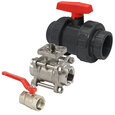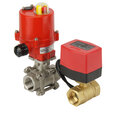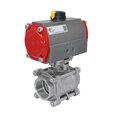Ball Valve Materials
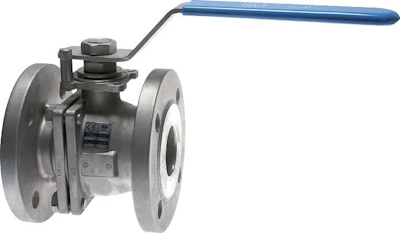
Figure 1: Stainless steel flanged ball valve
Ball valve material selection is crucial because it directly impacts the valve's durability, corrosion resistance, and suitability for specific applications. The various housing materials for ball valves are stainless steel, plastic, brass, and cast iron. Each material has different properties; hence, choosing the right material ensures optimal system performance, safety, and cost-efficiency. This article explores the various housing and seal materials for ball valves.
Table of contents
- Ball valve housing materials
- Ball valve seal materials
- Brass ball valves
- Stainless steel ball valves
- PVC ball valves
- Cast iron ball valves
- FAQs
View our online selection of ball valves!
Ball valve housing materials
The material for the ball valve body should be selected based on the fluid's temperature, pressure, and corrosive nature. The seal material can also affect the ball valve temperature rating. Choosing the wrong material can result in early wear, corrosion, and valve body failure.
Table 1: Typical pressure and temperature range for common ball valve housing materials
| Ball valve material | Temperature range (𐩑C) | Temperature range (𐩑F) | Max pressure (bar) | Max pressure (psi) |
| Brass | -20 to 160 | -4 to 320 | 55 | 798 |
| PVC | -10 to 60 | 14 to 140 | 16 | 232 |
| Stainless steel | -40 to 220 | -40 to 428 | 70 | 1015 |
| Cast iron | -20 to 120 | -4 to 248 | 40 | 580 |
| Steel | -20 to 180 | -4 to 356 | 40 | 580 |
| Zinc-plated steel | -10 to 80 | 14 to 176 | 500 | 7252 |
| Nickel-plated brass | -10 to 80 | 14 to 176 | 210 | 3046 |
Ball valve seal materials
Ball valves with Teflon, EPDM, and FKM seats are commonly used. They can also be made of metals or synthetic materials, such as NBR or polyamide. Read our chemical resistance of materials for more information on the suitability of different ball valve seat materials for various media.
Table 2: Common seal materials for ball valves
| Material | Temperature range (𐩑C) | Temperature range (𐩑F) | Key properties | Limitations |
| PTFE (Teflon) | -30 to 180 | -22 to 356 | Resistant to almost all fluids; suitable for high-pressure and high-temperature applications | Lacks flexibility, not ideal for low-pressure applications |
| FKM (Viton) | -10 to 120 | 14 to 248 | Highly chemical resistant, strong mechanical properties, resists compression set | Does not resist hot water and steam, can swell at elevated temperatures, unsuitable for polar solvents, certain esters, and ethers |
| EPDM | -10 to 130 | 14 to 266 | Suitable for water, steam, ketones, alcohols, low-concentration acids, and alkalis; excellent resistance to weathering and ozone | Does not resist oil, grease, and solvents well, unsuitable for aromatic hydrocarbons |
Brass ball valves
Advantages
-
Durability and strength:Brass ball valves are robust and can handle high pressures (up to 55 bar/798 psi) and temperatures (up to 160 °C/320 𐩑F).
- High-pressure versions with nickel plating are available for hydraulic applications, handling pressures up to 210 bar (3046 psi).
- Media suitability: Brass is suitable for neutral and noncorrosive media. It works well with water, compressed air, and oils.
- Compatibility: Works with various piping materials, including steel, copper, and PVC.
- No lead options: Available for potable water applications, ensuring safety and compliance with health standards.
Disadvantages
- Brass is more expensive than plastic.
- Not suitable for chloride solutions or demineralized water, acids, and salt water. Dezincification brass (corrosion-resistant brass) or nickel-plated brass is used for these media.
- Less strong than stainless steel in high-pressure applications.
Applications
- Residential plumbing: Ideal for controlling water flow in home plumbing systems.
-
Drinking water systems: Brass ball valves are commonly used in potable water systems due to their safety and reliability.
- Ensure brass ball valves have the necessary approvals for specific applications, such as KTW and/or DVGW for drinking water.
- HVAC and Irrigation: Brass ball valves are ideal for regulating fluid flow in heating, ventilation, air conditioning, and irrigation systems.
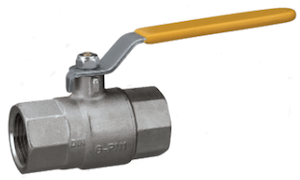
Figure 2: Brass ball valve
Stainless steel ball valves
Advantages
- High temperature and pressure resistance:Stainless steel ball valves are highly durable, resisting leaks in high-temperature (up to 220 °C/428 𐩑F) and high-pressure (up to 70 bar/1015 psi) environments.
-
Corrosion resistance: Offers superior corrosion resistance compared to brass or plastic, making it ideal for marine environments and applications involving corrosive substances.
- Stainless steel 304 and 316 are commonly used for ball valves, with Type 316 offering better corrosion resistance.
- Sanitary compliance: Stainless steel meets strict hygienic standards.
- Easy maintenance: Smooth surfaces are easy to clean, reducing maintenance requirements.
Disadvantages
- Cost and weight: Stainless steel ball valves are heavier and more expensive, which might be excessive for simple applications.
- Unsuitable media: Stainless steel is unsuitable for hydrochloric acid, bromine, and chlorides. Swimming pools usually have a low concentration of chlorides, so stainless steel 316 is used.
- Higher operating torque: Requires more force than PVC or brass valves.
Applications
- Marine and chemical industries: Ideal for environments with high chloride content, such as swimming pools and seawater systems.
- Specialized gas and oxygen applications: Designed to meet specific safety and performance standards.
- Food and pharmaceutical: The food, pharmaceutical, and biotechnology industries use stainless steel ball valves with sufficient sanitary approvals.
Stainless steel vs steel ball valves
- Stainless Steel: Best for wet, corrosive environments like food processing and pharmaceuticals due to its corrosion resistance.
-
Steel: Carbon steel is typically used in high-pressure, high-temperature settings, such as the oil and gas industries. Its properties can be improved by plating or alloying.
- Cast steel: Durable and moldable into complex shapes, suitable for industrial machinery.
- Zinc-plated steel: Features a zinc coating for enhanced corrosion resistance, making it suitable for hydraulic applications and moist environments.
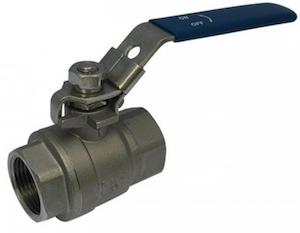
Figure 3: 2-way stainless steel ball valve
PVC ball valves
Advantages
- Lightweight:PVC ball valves are lightweight, easy to handle, and install.
- Corrosion resistance: PVC does not corrode, making it suitable for applications involving corrosive substances.
- Chemical resistance: It is resistant to many chemicals, sea water, acids, bases, and salt solutions, making it versatile for diverse industrial applications.
- Environmental impact: PVC is recyclable and has a relatively low environmental impact compared to other plastics.
- Sanitary applications: Safe and reliable for drinking water and food products.
Disadvantages
- Temperature and pressure limitations: It is not suitable for temperatures above 60 °C (140 °F) or pressures above 16 bar (232 psi).
- Strength: Generally not as strong as brass or stainless steel at high temperatures and pressures.
- Chemical limitations: PVC is not resistant to aromatic and chlorinated hydrocarbons.
Applications
- Residential plumbing and irrigation: Commonly used for shut-off valves in home water systems and irrigation setups.
- Swimming pools: Perfect for swimming pool systems; they can handle chlorinated water without corroding.
- Water treatment: Suitable for systems that require corrosion-resistant materials.
Types of PVC
- PVC-U (Unplasticized PVC): It does not contain phthalates and is used for standard applications.
- PVC-C (Chlorinated PVC): More heat resistant and suitable for hot water applications, but more expensive.
In addition to PVC, several other plastic materials, such as PP, PVDF, and PE, are also used for ball valves. Each offers unique properties that make it suitable for specific applications.

Figure 4: True union PVC ball valve with solvent socket
Cast iron ball valves
Advantages
- Durability:Cast iron ball valves are robust and suitable for heavy-duty use (up to 40 bar/580 psi and 120 𐩑C/248 𐩑F). They are ideal for environments where wear and tear may be an issue.
- Corrosion resistance: Cast iron water ball valves can withstand water-induced corrosion. Protective layers can enhance their corrosion resistance.
Disadvantages
- Brittleness: Cast iron is rigid and brittle, which can break with excessive stress.
- Weight: Heavier than other materials, which may complicate installation and handling.
Applications
- Water systems: Used for long-term applications in water distribution and treatment systems.
- Climate engineering: Suitable for HVAC systems and other climate control applications.
- Chemical and petrochemical Sectors: Employed in systems where durability is crucial.
Types of cast iron
- GG25 (GJL-250): Offers good machinability and wear resistance, ideal for moderate-strength applications like water and steam systems.
- GGG40: Provides higher tensile strength and impact resistance, suitable for demanding applications in the oil and heavy industries.
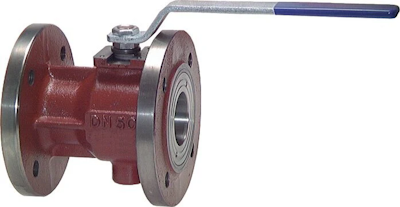
Figure 5: Cast iron flanged ball valve
FAQs
Which material is used for the ball valve?
Brass, stainless steel, PVC, and cast iron are the most common housing materials for ball valves.
What are brass ball valves used for?
Brass ball valves are used in commercial and residential plumbing systems, HVAC, and irrigation.
Are stainless steel ball valves lead-free?
Yes, stainless steel ball valves are typically lead-free, as stainless steel does not contain lead.
Are brass or stainless steel ball valves more durable?
Stainless steel ball valves are generally more durable and withstand higher pressures and temperatures than brass.




